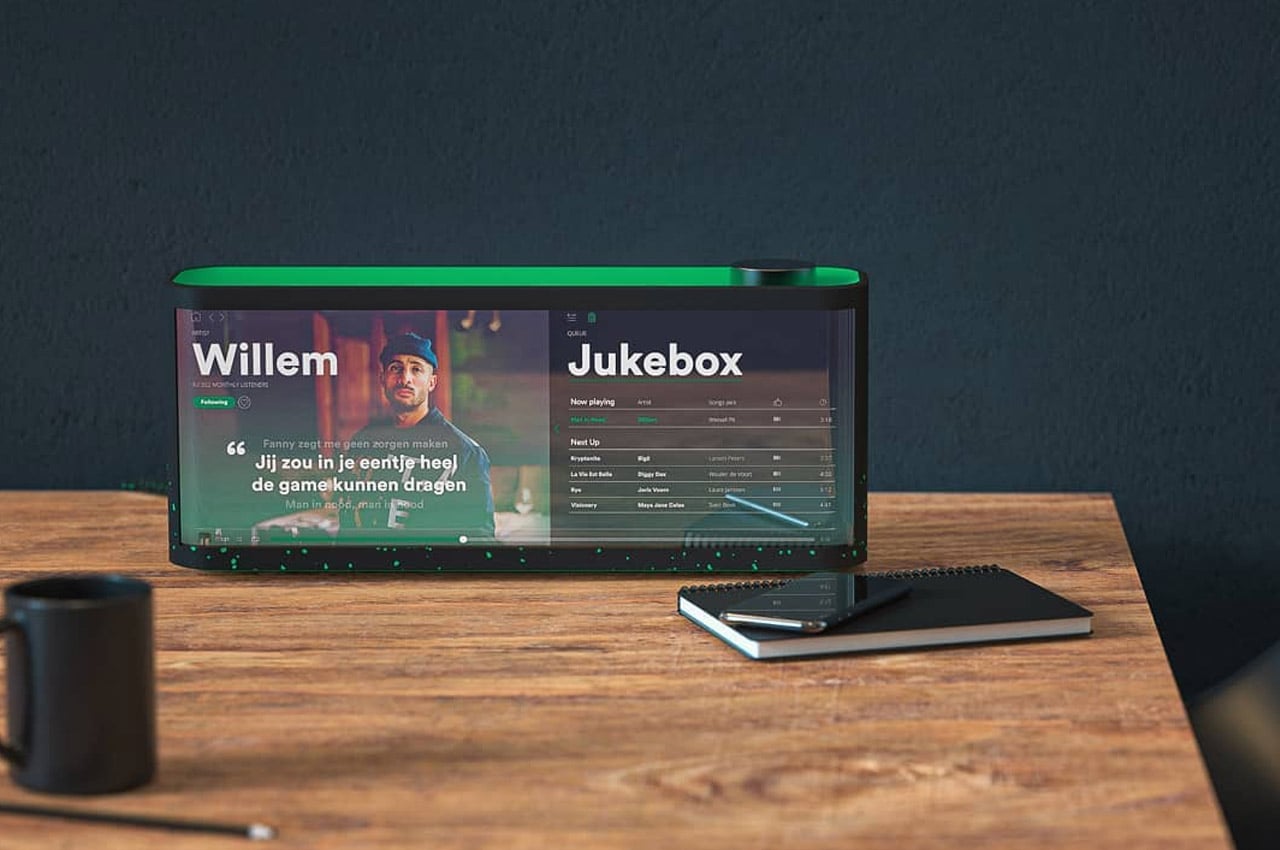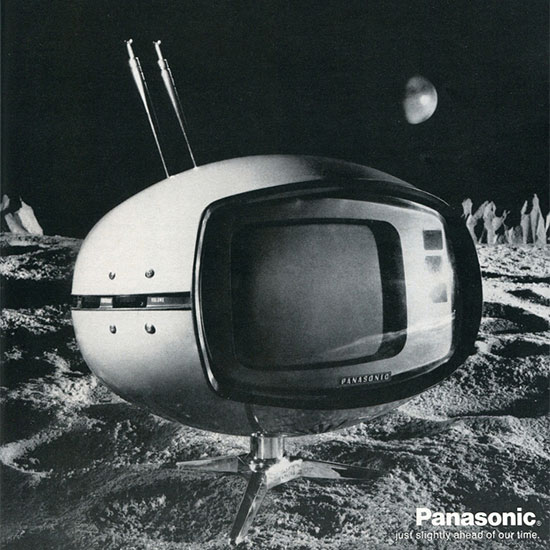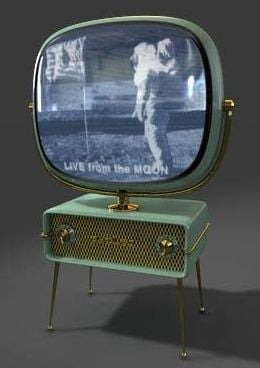Background

Hypothetical Spotify-branded jukebox: https://www.yankodesign.com/2022/05/03/spotify-jukebox-boasting-a-curved-display-brings-house-parties-to-your-desk/
For some background, I intend to create a desktop music-control device that interfaces with my Spotify library. This device will be comprised of an old TV and a Raspberry Pi and use Bluetooth/WiFi to connect to some existing speakers. Initially, I hoped to use the Space Age aesthetic due to its streamlined geometric forms and bold colors. See some examples of Space Age design below:

Jetson’s Show: https://www.archdaily.com/981405/the-space-age-aesthetic

Space Age Interior Design: https://www.elledecor.com/it/best-of/a36020093/design-favorites-of-the-week-space-age-style/
The Jetson’s cartoon, seen above, is a common instance of Space Age design. When I started exploring this project idea, I first attempted to source a TV from the era. Below are some examples of TVs that fit the aesthetic from the 1960s-1970s.

Panasonic TV (1971): https://mztv.oncell.com/en/7-space-age-tv-146591.html

Philco TV (1960s): https://www.reddit.com/r/1960s/comments/rc24y7/vintage_space_age_television_set_1960s/
Due to the age of these TVs, it was difficult to find a working model for sale. I used websites such as Facebook Marketplace, eBay, and Etsy for the procurement of the TV. There were a few pieces in excellent condition that were tested but they were all about $300 or more. While these models would have fit the aesthetic well, this high cost prohibited me from choosing the Space Age style.
Cassette Futurism
After deciding that the Space Age aesthetic was not feasible for my project, I started looking at the other options available on the market. A lot of the more affordable and working condition TVs that I could find fit the cassette futurism aesthetic. This aesthetic was most evident in the late 1960s-1990s and featured more squared-off, utilitarian, and monotone styling with functional and tactile elements.

Cassette Futurism: https://www.reddit.com/r/cassettefuturism/comments/ptivri/alien_isolation_is_one_of_the_best_examples_of/
As seen above, cassette futurism is significantly different from the Space Age aesthetic. However, I still believe that this style in conjunction with the modern Spotify interface will provide a unique user experience. I have yet to get my hands on a TV for the project but I was able to find a potential model (below) on Facebook Marketplace for $30.

Sony 204-UW Mini TV (1965) – https://www.artstation.com/artwork/68lEo5
This TV, with its blocky body and practical controls, definitely fits the cassette futurism aesthetic. Additionally, I think the fact that it’s Sony-branded adds an intriguing aspect to the piece.
Hardware Fabrication
The basic format for the fabrication of this project is split into hardware and software. On the hardware front, I will need to buy the correct equipment to adapt the display output of the Raspberry Pi to the TV. Furthermore, I need to develop physical controls for features such as play/pause, volume, track skipping, and mount Raspberry Pi to the existing TV.
The Raspberry Pi 4 I sourced from the ITLL has an HDMI output. Obviously, a TV from the 1960s/70s does not have one so some adapting is necessary. First, I will need to convert the digital HDMI signal to an analog composite signal. Converters that do this are available on Amazon for fairly cheap and require a power source.
Composite audio/video (AV) connections were common in the 90s and early 2000s in devices such as VCRs, DVD players, and game consoles. However, the older TVs only had the necessary hardware to receive signals over the air via an antenna. This prevented them from having any ports such as composite AV.
Due to this limitation, the composite AV signal will be need to adapted into a radio frequency (RF) signal. In the past, this signal would be transmitted by a TV station and received by an antenna on the TV. By converting the composite AV signal to RF, I am essentially “tricking” the TV into thinking that is it receiving radio waves. The device that accomplishes this is known as an RF modulator. Like the HDMI to composite converter, this product is readily available online and requires a power source.
While all this may sound complicated, many people have used a setup like this in the past and there is readily available documentation online. I am hoping to use some sort of extension cord/splitter to plug everything into so that only one or two outlets are needed to power the system.
After all the display components are working, I need to design and manufacture a method for mounting them and the Raspberry Pi. In an ideal world, I would like to mount everything inside the body of the TV itself for a cleaner look. The Sony TV I am hoping to buy looks fairly small so I am not sure if this is feasible, but I will only be able to determine that after I have it on hand. If I am not able to mount everything inside the TV, I plan on using 3D-printed and laser-cut parts to create an attached enclosure. To make the aesthetic more seamless, I plan to use metallic paint or a covering to make the enclosure match the rest of the TV. As an alternative, I could also use some wood to make the housing. While this would not blend in with the rest of the TV, I think that it would contrast well.
The final aspect of the hardware is the controls. While I would be able to hook up a mouse and keyboard to the Raspberry Pi, that does not seem like the most elegant solution. Ideally, I want to add some form of physical controls so that I can play/pause, rewind/fast-forward, and change the volume of tracks. Simple buttons and knobs (potentiometers) can easily be interfaced with through the GPIO pins of the Raspberry Pi. I have some experience with this from past projects so I do know that this is very feasible. The stretch goal with the controls would be to retrofit the existing TV buttons with the music controls. If needed, I could also make custom button/knob covers that fit into the holes of the existing parts as well. I think that having the TV look as it did in the past would make the whole project super satisfying. I have done some soldering and electronics work in the past but I hope to learn more while working on these controls.
Fabrication – Software
The other half of the project involves the software running on the Raspberry Pi. The main functions of this software are to connect to my Spotify account over WiFi, display my music library, take in control inputs, and play the music on my speakers. over Bluetooth/WiFi. Many hobbyists have used the Raspberry Pi with Spotify in the past, so there are a couple of options on the software front. After doing some research, the best prospects are a program called Mopidy or building a custom app using the Spotify API. Mopidy is an open-source music control interface available for free that has a lot of good documentation. There are other similar programs, but I feel like Mopidy has the cleanest UI design. Building my own interface with the Spotify API would be challenging, but it would allow me to have a lot of customization. There is also a lot of documentation for this approach and using the official API may reduce some latency. However, I most likely going to go with Mopidy due to the fact that I don’t need to put in the time to code anything.
The other parts of the software for this project have to do with interfacing with hardware. I will have to convert the signals taken in by the Raspberry Pi GPIO pins and re-map them so that they control the appropriate function in Mopidy. This can probably be done through keyboard key re-mapping or a similar feature. Besides this, I also need to format the display size in software so that it shows up properly on the TV. Most modern computers/laptops use a 16:9 aspect ratio, but older electronics like these mini TVs traditionally employ a 4:3 aspect ratio. I am hoping that Mopidy scales properly to this display format, but I need to look into it more.
Schedule
Below is my current schedule for the project:
- Source TV: by 3/22
- Get Spotify interface working: by 3/22
- Purchase display hardware: by 3/22
- Button and controls integration: by 4/12
- Enclosure and mounting: by 4/17
- Testing and final presentation work: 4/17-4/24
I have already contacted the seller of the Sony TV on Facebook Marketplace and was hoping to pick it up this weekend, but some logistical issues arose. However, I am confident that I will be able to have it on hand by this Friday, 3/22. This week, I plan on working on getting Mopidy set up on the Raspberry Pi and ordering the display hardware from Amazon. I believe that these two tasks can be done in parallel, not requiring me to physically have the TV first. After spring break, I plan to tackle the controls and mounting aspects of the project. I think that this timeline gives me enough time to troubleshoot issues and consult resources such as the ITLL or Ideaforge electronics staff. With the project due on 4/24, I gave myself a week to test and iron out the final kinks.
Conclusion
All in all, I believe that I will be able to finish this project with a reasonable budget and timeline. I hope to build more on my previous experience with the Raspberry Pi and produce a functional yet aesthetically pleasing product.


4 Comments. Leave new
This is such a cool idea, looking forward to seeing the progress! Will you incorporate speakers into the system?
Arjun, I am very excited to follow your project as you assemble and integrate the electronics. I think it would be a great decoration even without the music playing functionality. Do you have a backup plan in case they don’t end up being compatible with each other? It seems like a cool electromechanical challenge within an aethetic challenge!
Hi Arjun, this project looks awesome. You have defiantly done lots of research and your plan sounds great. Will the Raspberry pi be exposed or hidden inside the project?
Wow Arjun I think this is a really great concept and could be a very cool concept when completed. I really like that you are trying to make a project that is useable. You’re cassette futurism aesthetic is a really cool concept and I like the rustic electronics look. I was wondering if you have any raspberry pi software experience in the past? this seems like a challenging endeavor and I’ll be intrigued to see the final product!